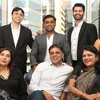Product, price, place, promotion, experience – how six technologies are transforming marketing
This informative book explains how startups and large firms are employing AI, ML, robots, drones, IoT and blockchain for creative marketing.
Launched in 2012, YourStory's Book Review section features over 315 titles on creativity, innovation, entrepreneurship, and digital transformation. See also our related columns The Turning Point, Techie Tuesdays, and Storybites.
Tech transformations of marketing are well-captured in the book, Intelligent Marketing: Employing New-Age Technologies, by ISB Professor V Kumar. New waves of technology are making marketing both more experiential and instantaneous, and call for continuous learning.
The book is written in academic style, and the eight chapters are thoroughly referenced. But surprisingly, the book has no index or glossary of terms. Technologies like augmented reality (AR) and virtual reality (VR) are not highlighted either.
Each chapter traces the growth of the technology, business impacts, use cases in marketing, and future trends. Effective use of these technologies at the strategic rather than just tactical level calls for major changes in organisational capabilities, processes, and culture, Kumar advises.
“Amazon has truly embraced an ever-evolving digital ecosystem,” he observes, pointing to the rise of AWS, Alexa, Prime, Managed Blockchain, recommendations, and warehouse robotics. Netflix is another company that has effectively unified a range of technologies, data insights, content assets, creative talent, and business strategies.
Converging technologies give rise to better ability to sense, interpret, adapt and respond in real time. Hybrid human-machine collaborations are enabling new kinds of business competencies as well, Kumar explains. There are also larger implications for society, governance, ethics, and policy.
Here are my key takeaways from the 300-page book, summarised as well in the table below. See also my reviews of the related books Future Tech, Innovation Ultimatum, Seeing Digital, Fintech Future, Out-Innovate, The Next Billion Users, and Machine, Platform, Crowd.

I. AI
AI combines data insights, pattern recognition, predictive power, and decision making. Deep learning draws on layers of neural networks in ways similar to the human brain. Applications include travel planning, smart homes, personalised learning, and self-driving cars.
In marketing, AI helps create customer profiles, curate content, decide on product offers, and personalise communication campaigns. Creating deeper bonds improves customer engagement and relationships, Kumar observes.
Examples include L’Oreal (social media monitoring), McCann (scripting commercials), Spotify (weekly curated playlists), Ogilvy-Nestle (nutrition assistant in China), and Jet (real-time pricing updates). AI has been used to improve email marketing, and social robots have been deployed in Japanese shopping malls.

II. ML
ML focuses on developing, understanding, and evaluating learning algorithms. The machine teaches itself based on existing data, via methods like supervised learning (eg. for speech recognition, spam filtering), unsupervised learning (for fraud detection, image recognition), and reinforcement learning (for news recommendation, autonomous cars).
Kumar showcases ML in action in healthcare (PathAI for accurate diagnosis), building management (75F), food waste tracking (Hitachi), facial recognition (iPhone), email auto-fill (Gmail), financial planning (Olivia), smart homes (Nest), and credit scoring (Lenddo).
Marketing examples include voice interfaces for customer interaction, recommendation engines (ecommerce), route planning (Uber), dynamic pricing (Airbnb), fraud detection (American Express), and menu recommendations (Taco Bell).
Other instances cited are sales forecasting (German online retailer Otto), personalised artwork selection (Netflix movie titles), hotel room pricing (Bavaria Boutique Hotel), fan promotions (Kansas City Chiefs), robot concierge (Hilton’s Connie), order prediction (Domino’s), and in-store recommendations (Macy’s On Call).
Kumar identifies future trends such as hybrid use of ML in online as well as physical environments, and ML complementing existing CRM systems. Due to some perceptions of uneasiness and even revulsion, it will be important to address some consumer issues of trust with the increasing use of machines instead of humans.

III. IoT
The term IoT was first coined by Kevon Ashton in 1999, and has now become a gamechanger in a range of sectors at the level of individual (wearables), organisation (eg. traffic monitoring sensors by Hamburg Port Authority), industry (fleet management, manufacturing), and nation (smart city).
Marketing examples by category in the ‘4 Ps’ include product (Diageo smart bottles), price (Burger King geofencing for campaigns), place (beacons at Walgreens, Heathrow Airport), and promotion (Nivea Sun Kids bracelets for monitoring on Brazil’s beaches).
Kumar also cites examples like fitness trackers (FitBit), smart locks (Wyze), geofencing (location-based marketing by Sephora), smart homes (ambient assisted living), and asset management (Istanbul Airport). Other instances include asset tracking (An Post), smart grids (Honeywell), fleet management (Bransys), Tesla (remote software updates), and Industry 4.0 (preventive maintenance by ABB, Hitachi).
An effective example of convergence is the Amazon GO store’s ‘just walk out technology,’ with IoT sensors, machine vision, and a mobile app.
A number of smart city initiatives are based on IoT as well, such as pedestrian and traffic tracking (Mulhouse, France), management of water and parking (Barcelona), environmental tracking (Las Vegas), public service tracking (Padova), and energy management (Kashiwa-no-ha in Japan).

IV. Robots
Interestingly, the words robot and robotics were first featured in literary works (Czech play, science fiction). The author traces the rise of industrial robotics, robotic arms, vision-enabled robots, and today’s personal services robots and industrial cobots.
Robots can perform tasks like vacuum cleaning (Roomba, Eufy), floor washing (iRobot, iLife), disinfection (UVD Robotics), swimming pool cleaning (Dolphin, Aquabot), window washing (Hobot, Gecko), lawncare Robomow), butlers (Ugo, Moro), and even social companionship (Pepper, Buddy, Kiki).
Other capabilities of robots include motion assistance (Exo-Suit exoskeletons), warehouse management (DHL), retail store assistance (Walmart’s Bossa Nova), and special needs education (QTrobot).
In the marketing world, robots have contributed in the ‘4 Ps’ – product (robotic products, eg. Echo, Roomba, Walmart’s autonomous shopping cart Dash), price (shopbots – Nao, BizRate), place (senior care companions), and promotion (store inspection, product ‘pick and place’).
Other cited examples include Honey (coupon bot), eBay (shopbot), Finnish telco Elisa (Pepper robot for desk service), and Heathrow Airport (robots communicating in multiple languages with passengers).
Trends to watch include the rise of 5G for the ‘Tactile Internet’, and changes in regulation as well as citizen acceptance of machines.

V. Drones
Drones have also been referred to as unmanned aerial vehicles (UAV) or remotely piloted aircraft (RPA). Originally used by the military, they are now spreading to commercial, scientific, consumer, and public service markets as well.
Examples include aerial photography, wedding videos, drone racing, construction site monitoring, irrigation leak detection, retail delivery, and operations in large stores. Kumar also cites drone application in COVID-19 operations (surveillance in India, medical supplies by Zipline in Ghana).
Drones have been used for damage inspection by insurance companies (Allstate, Liberty Mutual), and powerline inspections by utility firms (Dominion Energy, Oklahoma G&E). Creative frontiers include carrying promotional flyers past Moscow office windows (Wokker Noodles).

VI. Blockchain
Blockchain is the most recent of the new-age technologies tracked in the book, with value propositions in decentralised, authentic, transparent, and secure operations.
Applications include knowledge management, legal processes in real estate (Ubiquity), artist license transactions (Monegraph), information safety of blood samples (LifeBank), digital voting (Voatz, BitCongress), and ridesharing (Arcade City, Drife, TADA).
Kumar cites marketing examples such as food product authenticity and journey safety (Hungry Coin, Walmart), pharmaceutical tracking (BlockVerify), supply chains (EverLedger), engine usage history (Renault), and consumer game engagement (Miller Lite).
Other instances are diamond traceability assurance (De Beers), authenticity proof (LVMH), financial data handling (KLM), payment automation (Data Gumbo in the oil industry), merchant reward points (Singapore Airlines), geoblockchain (GIS integration, by Porsche, Nespresso), ad reconciliation (Unilever), and ad strategy (Toyota).
Kumar identifies future trends such as the rise of new disruptive business models, the need to address user concerns over privacy and theft, and opportunities in programmatic advertising.

The road ahead
The concluding chapter emphasises the need to be able to unify and integrate these technologies rather than treating them as separate blocks. Companies need to have data-centric cultures and processes, and be willing to embrace transparency and automation, Kumar advises.
Long term benefits will accrue from strategic approaches rather than merely tactical steps. Tech impacts will span B2C as well as B2B and internal stakeholders. Business leaders will need to augment employee capabilities in knowledge management and customer engagement, Kumar recommends.
“Technology is a potent unifier,” he sums up. “When unifying and integrating, technology undoubtedly permeates our lives and gains permanence,” Kumar signs off.
YourStory has also published the pocketbook ‘Proverbs and Quotes for Entrepreneurs: A World of Inspiration for Startups’ as a creative and motivational guide for innovators (downloadable as apps here: Apple, Android).
Edited by Megha Reddy





1559140144500.jpg?fm=png&auto=format&h=100&w=100&crop=entropy&fit=crop)





